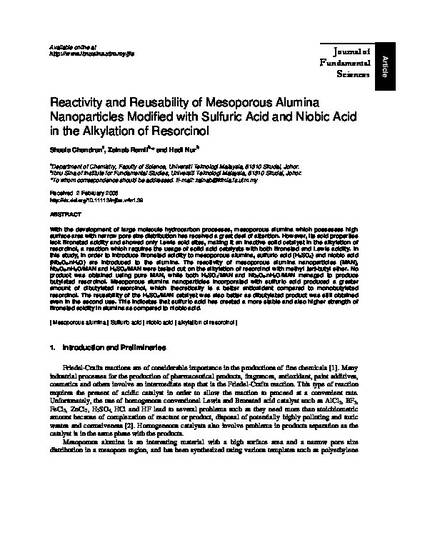
Article
Reactivity and Reusability of Mesoporous Alumina Nanoparticles Modified with Sulfuric Acid and Niobic Acid in the Alkylation of Resorcinol
Journal of Fundamental Sciences
(2008)
Abstract
With the development of large molecule hydrocarbon processes, mesoporous alumina which possesses high surface area with narrow pore size distribution has received a great deal of attention. However, its acid properties lack Bronsted acidity and showed only Lewis acid sites, making it an inactive solid catalyst in the alkylation of resorcinol, a reaction which requires the usage of solid acid catalysts with both Bronsted and Lewis acidity. In this study, in order to introduce Bronsted acidity to mesoporous alumina, sulfuric acid (H2SO4) and niobic acid (Nb2O5.nH2O) are introduced to the alumina. The reactivity of mesoporous alumina nanoparticles (MAN), Nb2O5.nH2O/MAN and H2SO4/MAN were tested out on the alkylation of resorcinol with methyl tert-butyl ether. No product was obtained using pure MAN, while both H2SO4/MAN and Nb2O5.nH2O/MAN managed to produce butylated resorcinol. Mesoporous alumina nanoparticles incorporated with sulfuric acid produced a greater amount of dibutylated resorcinol, which theoretically is a better antioxidant compared to monobutylated resorcinol. The reusability of the H2SO4/MAN catalyst was also better as dibutylated product was still obtained even in the second use. This indicates that sulfuric acid has created a more stable and also higher strength of Bronsted acidity in alumina as compared to niobic acid.
Keywords
- Mesoporous alumina,
- Sulfuric acid,
- niobic acid,
- alkylation of resorcinol
Disciplines
Publication Date
June 1, 2008
Citation Information
Sheela Chandren, Zainab Ramli and Hadi Nur. "Reactivity and Reusability of Mesoporous Alumina Nanoparticles Modified with Sulfuric Acid and Niobic Acid in the Alkylation of Resorcinol" Journal of Fundamental Sciences Vol. 4 (2008) Available at: http://works.bepress.com/hadi_nur/39/
